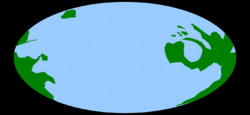Tonian
Topic: Earth
 From HandWiki - Reading time: 2 min
From HandWiki - Reading time: 2 min
| Tonian | |
|---|---|
| 1000 – ~720 Ma | |
 A map of the world as it appeared during the late Tonian, c. 750 Ma | |
| Chronology | |
| Etymology | |
| Name formality | Formal |
| Usage information | |
| Celestial body | Earth |
| Regional usage | Global (ICS) |
| Time scale(s) used | ICS Time Scale |
| Definition | |
| Chronological unit | Period |
| Stratigraphic unit | System |
| Time span formality | Formal |
| Lower boundary definition | Defined chronometrically |
| Upper boundary definition | Redefined chronometrically with an interim calibrated age of c. 720 Ma. GSSP is in progress.[1] (Previously defined chronometrically as 850 Ma)[2] |
| Upper boundary definition candidates | The first appearance of widespread glaciation.[3] |
| Upper boundary GSSP candidate section(s) | To be determined |
The Tonian (from Ancient Greek:, meaning "stretch") is the first geologic period of the Neoproterozoic Era. It lasted from 1000 to 720 Mya (million years ago). Instead of being based on stratigraphy, these dates are defined by the ICS based on radiometric chronometry. The Tonian is preceded by the Stenian Period of the Mesoproterozoic Era and followed by the Cryogenian.
Rifting leading to the breakup of supercontinent Rodinia, which had formed in the mid-Stenian, occurred during this period, starting from 900 to 850 Mya.
Biology
The first putative metazoan (animal) fossils are dated to the middle to late Tonian (c. 890-800 Mya). The fossils of Otavia antiqua, which has been described as a primitive sponge by its discoverers and numerous other scholars, date back to about 800 mya. Even earlier sponge-like fossils have been reported in reefs dating back to 890 million years before the present, but their identity is highly debated.[4] This dating is consistent with molecular data recovered through genetic studies on modern metazoan species; more recent studies have concluded that the base of the animal phylogenetic tree is in the Tonian.[5]
The first large evolutionary radiation of acritarchs occurred during the Tonian.
See also
- Earth:Boring Billion – Earth history, 1.8 to 0.8 billion years ago
- Neoproterozoic oxygenation event
References
- ↑ Shields, Graham A.; Halversonb, Galen P.; Porter, Susannah M. (2018). "Descent into the Cryogenian". Precambrian Research 319. doi:10.1016/j.precamres.2018.08.015.
- ↑ 2.0 2.1 Plumb, K. A. (June 1, 1991). "New Precambrian time scale". Episodes 14 (2): 139–140. doi:10.18814/epiiugs/1991/v14i2/005. https://www.episodes.org/journal/view.html?doi=10.18814/epiiugs/1991/v14i2/005. Retrieved 16 January 2023.
- ↑ Shields-Zhou, Graham A.; Porter, Susannah; Halverson, Galen P. (2016). "A new rock-based definition for the Cryogenian Period (circa 720 – 635 Ma)". Episodes 39 (1): 3–8. doi:10.18814/epiiugs/2016/v39i1/89231. ISSN 0705-3797. https://discovery.ucl.ac.uk/id/eprint/1496826/.
- ↑ Turner, Elizabeth C. (28 July 2021). "Possible poriferan body fossils in early Neoproterozoic microbial reefs". Nature 596 (7870): 87–91. doi:10.1038/s41586-021-03773-z. PMID 34321662. Bibcode: 2021Natur.596...87T.
- ↑ Kliman, Richard M. (Apr 14, 2016). Encyclopedia of Evolutionary Biology. Academic Press. p. 251. ISBN 9780128004265.
Further reading
- "Tonian Period". GeoWhen Database. http://www.stratigraphy.org/geowhen/stages/Tonian.html.
- Ogg, James G. (2004). "Status on Divisions of the International Geologic Time Scale". Lethaia 37 (2): 183–199. doi:10.1080/00241160410006492.
 |
 KSF
KSF